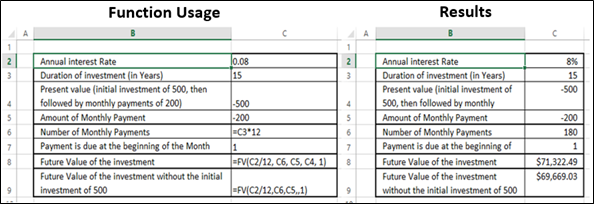
- Advanced Excel Functions Tutorial
- Advanced Excel Functions - Home
- Compatibility Functions
- Advanced Excel Functions - Cube
- Database Functions
- Date & Time Functions
- Engineering Functions
- Financial Functions
- Information Functions
- Advanced Excel Functions - Logical
- Lookup & Reference Functions
- Math & Trignometric Functions
- Statistical Functions
- Useful Resources
- Quick Guide
- Useful Resources
- Discussion
Advanced Excel Financial - FV Function
Description
The FV function calculates the future value of an investment based on a constant interest rate. You can use FV with either periodic, constant payments, or a single lump sum payment.
Syntax
FV (rate,nper,pmt,[pv],[type])
Arguments
| Argument | Description | Required/ Optional |
|---|---|---|
| Rate | The interest rate per period. | Required |
| Nper | The total number of payment periods in an annuity. | Required |
| Pmt | The payment made each period. It cannot change over the life of the annuity. Typically, pmt contains principal and interest but no other fees or taxes. If pmt is omitted, you must include the pv argument. |
Required |
| Pv | The present value, or the lump-sum amount that a series of future payments is worth right now. If pv is omitted, it is assumed to be 0 (zero), and you must include the pmt argument. |
Optional |
| Type | The number 0 or 1 and indicates when payments are due. See Table given below. If type is omitted, it is assumed to be 0. |
Optional |
| Set type equal to | If payments are due |
|---|---|
| 0 | At the end of the period |
| 1 | At the beginning of the period |
For more description of the arguments in FV and for more information on annuity functions, see PV.
Notes
Make sure that you are consistent about the units you use for specifying rate and nper
If you make monthly payments for four years at 12 percent annual interest, use 12%/12 for rate and 4*12 for nper
If you make annual payments for four years at 12 percent annual interest, use 12% for rate and 4 for nper
For all the arguments,
cash you pay out, such as deposits to savings, is represented by negative numbers
cash you receive, such as dividend checks, is represented by positive numbers
If any of the specified arguments is non-numeric, FV returns #VALUE! error
Applicability
Excel 2007, Excel 2010, Excel 2013, Excel 2016
Example
